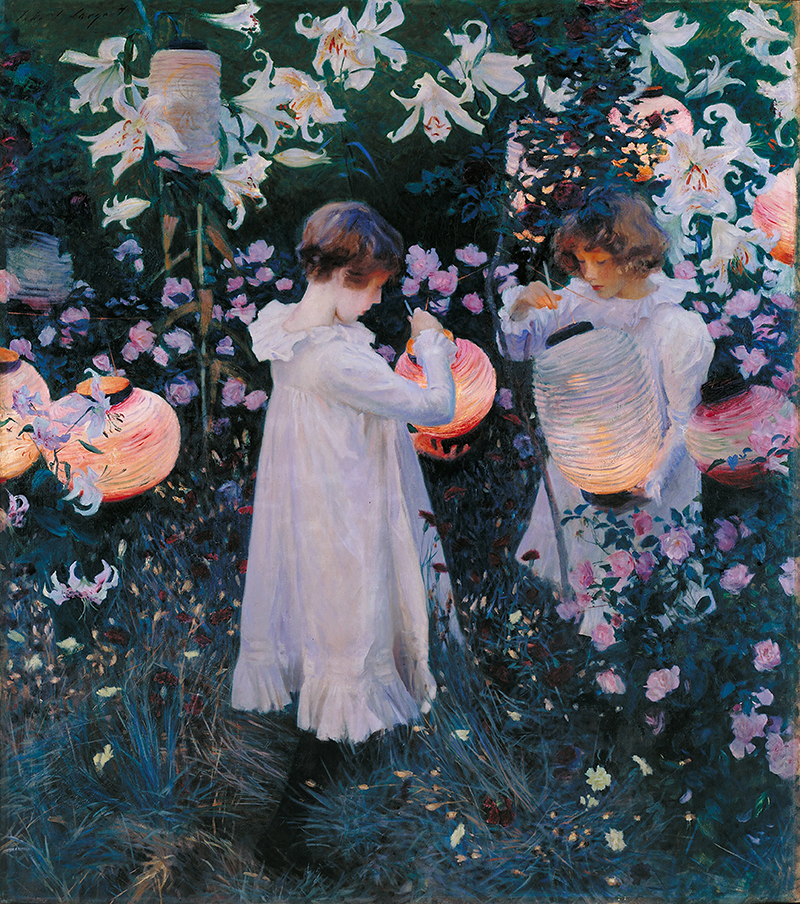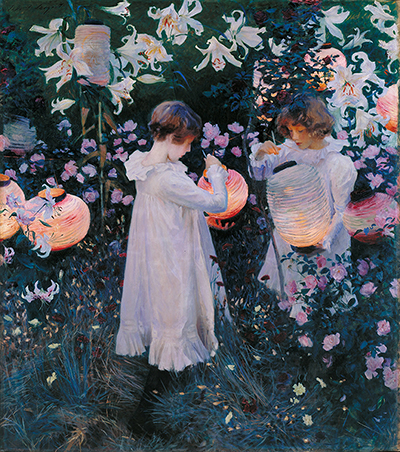The image of childhood innocence, that is the best description of this painting. John Singer Sargent painted the Carnation, Lily, Lily, Rose in the year 1885 and 1886
This marked the revival of his career in painting after he took a break to Broadway, Worcestershire for the summer seasons.
1§ Carnation, Lily, Lily, Rose was painted at this place. His first inspiration came to him when he got a view Chinese lanterns hanged in trees along the Thames at Pangbourne while taking an evening boat ride.
At the time John Singer Sargent was painting the Carnation, Lily, Lily, Rose, he was staying at Francis David Millet’s home. He would spend time with his friend during the day then work on the painting late as the light faded into evening. This explains why the painting has shades of the faded sunset.
The Theme of the Artwork
Mr Sargent and his friends loved the song “The Wreath” That had lyrics on the refrain “Carnation, Lily, Lily, Rose” That is where the painting got its name from. The painting shows two young girls aged eleven and seven years old, holding lanterns.
These were daughters of Frederick Barnard, Francis David Millet’s friend. Initially, Sargent had chosen his host’s five-year-old daughter, but Barnard’s daughters were perfect for the painting. More so, because they had blonde hair and their ages were just what John Singer needed for his painting.
Dorothy Barnard and Polly Barnard posed for painting while they were innocently playing, and Sargent would tell them to hold their position so he would sketch them. He would bring his drawing tools outside to capture the moment on canvas.
The surviving sketches of the Carnation, Lily, Lily, Rose showed that Sargent had made many sketches of the two girls while they were playing before he got the right position for his painting.
It is rumoured that the artist had so much fun making the painting that is why probably he took about two years to get the painting done.

Painting Techniques
When this painting was unveiled, it amused many people including scholars. They were amazed at the kind of painting techniques he had used in the Carnation, Lily, Lily, Rose. He used the impressionist techniques for the painting; popularly known as en plein air technique. He learnt the painting technique from his old friend Monet back in Paris.
The painting technique involves using a natural setting, that is the outdoor, as well as the natural light. Because Mr Sargent wanted to capture the twilight glow just after the sunset, he used to paint the Carnation, Lily, Lily, Rose for few minutes every day before the nightfall. This is also another reason why the painting took long before it was completed.
Impressionists are famously known to concentrate on the effects of light on their paintings. John Singer Sargent attended his artistic training in Paris, and this is where he learnt the impressionist painting technique.
While still in Paris, he attended a lot of exhibitions where paintings that had implemented the impressionist technique were on display to the public. Through all this exposure of the impressionist technique, Sargent decided to use it on the Carnation, Lily, Lily, Rose.
The painter also used the Realism technique. By simply using actual people in the painting confirms that he is a realist. Both the realist and the impressionist technique were used in the painting.
The Materials Used
When the Carnation, Lily, Lily, Rose was being created, the painter used canvas and oil paint. The oil paint is a slow drying paint while the canvas ensured the durability of the painting.
Analysis of the Artwork
The painting has the effects of the sunset, starting with the colour, the perfect light, and the shadow. The painter did a perfect job in the painting; all these effects are evident in the artwork.
Lighting
When you take a look at the artwork, the time of day when the sun was almost setting was successfully captured by the painter. The lighting in the lanterns brings a glow to the painting.
Use of Colours
The orange colour produced by lanterns has reflected on the girl’s faces.
The colour of the girls’ dresses, the flowers surrounding the girls, and grass has successfully been captured by the painter in their original state. The artwork clearly captured the original state of the moment, with everything in its original colour.
Emotions
A close look at the artwork will show a clear picture of childhood innocence. The girls’ view is directed to the lanterns to indicate complete concentration on the lantern but one can tell how innocent they look.
Where is the Painting Today?
The Carnation, Lily, Lily, Rose was sold to British Royal Academy in 1886 for an undisclosed amount of money. Today, the painting is at Tate Gallery where it can be viewed by the entire public. The artwork has since attracted so many people to view the beauty of art created by John Singer Sargent.
Artists Related to John Singer Sargent’s Work
Frederick Barnard - He too was an artist who was friends with Mr Sargent. His two daughters, Dolly and Polly Barnard, were the models in the Carnation, Lily, Lily, Rose. Sargent has also painted other several canvas paintings of Barnard and his family.
Francis David Millet - When John Singer had gone to England during the summer season, he stayed at the home of Mr Millet. He had at some point chosen David’s five-year-old daughter to be the model of Carnation, Lily, Lily, Rose but later chose Barnard’s Daughters. David was also an artist.
Claude Monet - It was Monet that taught John how to use impressionist technique on paintings. John has also made other paintings of Monet.




